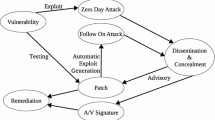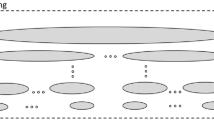Abstract
Many security breaches occur because of exploitation of vulnerabilities within the system. Vulnerabilities are weaknesses in the requirements, design, and implementation, which attackers exploit to compromise the system. This paper proposes a methodological framework for security requirements elicitation and analysis centered on vulnerabilities. The framework offers modeling and analysis facilities to assist system designers in analyzing vulnerabilities and their effects on the system; identifying potential attackers and analyzing their behavior for compromising the system; and identifying and analyzing the countermeasures to protect the system. The framework proposes a qualitative goal model evaluation analysis for assessing the risks of vulnerabilities exploitation and analyzing the impact of countermeasures on such risks.











Similar content being viewed by others
Notes
The highlighted color in the models does not bear any semantic significance and only intends to highlight the countermeasures in the figures.
References
Anderson R (2001) Security engineering: a guide to building dependable distributed systems. Wiley, London
IBM Global Technology Services (2008) IBM internet security systems X-force 2007 trend statistics
National Vulnerability Database. http://www.nvd.nist.gov/
SANS. http://www.sans.org/
Common Weakness Enumeration. http://www.cwe.mitre.org/
Common Vulnerability Scoring System. http://www.first.org/cvss/
Jürjens J (2004) Secure systems development with UML. Springer, Berlin
Liu L, Yu E, Mylopoulos J (2003) Security and privacy requirements analysis within a social setting. In: Proceedings of the 11th IEEE international conference on requirements engineering. IEEE Computer Society, pp 151–161
Giorgini P, Massacci F, Mylopoulos J, Zannone N (2006) Requirements engineering for trust management: model, methodology, and reasoning. Int J Inf Secur 5(4):257–274
Schneier B (1999) Attack trees. Dr. Dobb’s J 24(12):21–29
Sindre G, Opdahl AL (2005) Eliciting security requirements with misuse cases. Requir Eng 10(1):34–44
van Lamsweerde A (2004) Elaborating security requirements by construction of intentional anti-models. In: Proceedings of the 26th international conference on software engineering. IEEE Computer Society, pp 148–157
Asnar Y, Moretti R, Sebastianis M, Zannone N (2008) Risk as dependability metrics for the evaluation of business solutions: a model-driven approach. In: Proceedings of the 3rd international conference on availability, reliability and security. IEEE Computer Society, pp 1240–1248
Matulevicius R, Mayer N, Mouratidis H, Dubois E, Heymans P, Genon N (2008) Adapting secure tropos for security risk management in the early phases of information systems development. In: Proceedings of the 20th international conference on advanced information systems engineering, LNCS 5074. Springer, pp 541–555
Braber F, Hogganvik I, Lund MS, Stolen K, Vraalsen F (2007) Model-based security analysis in seven steps—a guided tour to the CORAS method. BT Technol J 25(1):101–117
den Braber F, Dimitrakos T, Gran BA, Lund MS, Stolen K, Aagedal JO (2003) The CORAS methodology: model-based risk assessment using UML and UP. In: UML and the unified process. IGI Publishing, Hershey, PA, pp 332–357
Elahi G, Yu E (2007) A goal oriented approach for modeling and analyzing security trade-offs. In: Proceedings of 26th international conference on conceptual modeling, LNCS 4801. Springer, pp 375–390
ISO/IEC (2004) Management of information and communication technology security—part 1: concepts and models for information and communication technology security management. ISO/IEC 13335
Kissel ER (2005) Glossary of key information security terms. NIST IR 7298
Schneider FB (ed) (1998) Trust in cyberspace. National Academy Press, Washington
Schneier B (2003) Beyond fear. Springer, Berlin
McDermott JP (2000) Attack net penetration testing. In: Proceedings of the 2000 workshop on new security paradigms. ACM, pp 15–21
Phillips C, Swiler LP (1998) A graph-based system for network-vulnerability analysis. In: Proceedings of the 1998 workshop on new security paradigms. ACM, pp 71–79
Avizienis A, Laprie J-C, Randell B, Landwehr CE (2004) Basic concepts and taxonomy of dependable and secure computing. IEEE Trans Dependable Secur Comput 1(1):11–33
Massacci F, Mylopoulos J, Zannone N (2008) An ontology for secure socio-technical systems. In: Handbook of ontologies for business interaction, Chap. XI. The IDEA Group
Schneier B (2007) The psychology of security. Commun ACM 50(5):128
Massacci F, Prest M, Zannone N (2005) Using a security requirements engineering methodology in practice: the compliance with the Italian data protection legislation. Comp Stand Interf 27(5):445–455
Yu ESK (1995) Modeling strategic relationships for process reengineering. PhD thesis, University of Toronto
Sindre G, Opdahl AL (2007) Capturing dependability threats in conceptual modelling. In: Conceptual modelling in information systems engineering. Springer, pp 247–260
Yu ESK (1997) Towards modeling and reasoning support for early-phase requirements engineering. In: Proceedings of the 3rd IEEE international conference on requirements engineering. IEEE Computer Society, pp 226–235
Chung L, Nixon BA, Yu E, Mylopoulos J (eds) (2000) Non-functional requirements in software engineering. Kluwer, Dordrecht
Horkoff J (2006) Using i* models for evaluation. Master’s thesis, University of Toronto
Vesely WE, Goldberg FF, Roberts N, Haasl DF (1981) Fault tree handbook. Technical Report NUREG-0492, U.S. Nuclear Regulatory Commission
Hoglund G, McGraw G (2004) Exploiting software: how to break code. Addison-Wesley Professional, Reading
Whittaker JA, Thompson H, Thompson HH, Thompson H (2003) How to break software security: effective techniques for security testing. Pearson
Schumacher M, Fernandez-Buglioni E, Hybertson D, Buschmann F, Sommerlad P (2006) Security patterns: integrating security and systems engineering. Wiley, London
Dardenne A, van Lamsweerde A, Fickas S (1993) Goal-directed requirements acquisition. Sci Comput Program 20:3–50
van Lamsweerde A, Letier E (2000) Handling obstacles in goal-oriented requirements engineering. IEEE Trans Softw Eng 26(10):978–1005
Bresciani P, Giorgini P, Giunchiglia F, Mylopoulos J, Perini A (2004) TROPOS: an agent-oriented software development methodology. J Auton Agents Multi-Agent Syst 8(3):203–236
Compagna L, Khoury PE, Krausová A, Massacci F, Zannone N (2009) How to integrate legal requirements into a requirements engineering methodology for the development of security and privacy patterns. Artif Intell Law 17(1):1–30
Massacci F, Zannone N (2008) A model-driven approach for the specification and analysis of access control policies. In: Proceedings of the OTM 2008 confederated international conferences, LNCS 5332. Springer, pp 1087–1103
Mouratidis H, Giorgini P (2007) Secure tropos: a security-oriented extension of the tropos methodology. Int J Softw Eng Knowl Eng 17(2):285–309
Asnar Y, Giorgini P (2006) Modelling risk and identifying countermeasure in organizations. In: Proceedings of the 1st international workshop on critical information infrastructures security, LNCS 4347. Springer, pp 55–66
Mayer N, Rifaut A, Dubois E (2005) Towards a risk-based security requirements engineering framework. In: Proceedings of the 11th workshop on requirements engineering for software quality
Mayer N, Heymans P, Matulevicius R (2007) Design of a modelling language for information system security risk management. In: Proceedings of the 1st international conference on research challenges in information science, pp 121–132
Mayer N, Dubois E, Matulevicius R, Heymans P (2008) Towards a measurement framework for security risk management. In: Proceedings of modeling security workshop, 2008
Haley C, Laney R, Moffett J, Nuseibeh B (2008) Security requirements engineering: a framework for representation and analysis. IEEE Trans Softw Eng 34(1):133–153
McDermott J, Fox C (1999) Using abuse case models for security requirements analysis. In: Proceedings of the 15th annual computer security applications conference. IEEE Computer Society, pp 55–66
Rostad L (2006) An extended misuse case notation: including vulnerabilities and the insider threat. In: Proceedings of the 12th working conference on requirements engineering: foundation for software quality
Jürjens J (2008) Model-based security testing using UMLsec: a case study. Electron Notes Theoretical Comput Sci 220(1):93–104
Jürjens J, Schreck J, Yu Y (2008) Automated analysis of permission-based security using UMLsec. In: Proceedings of 11th international conference on fundamental approaches to software engineering, LNCS 4961. Springer, pp 292–295
Acknowledgments
Financial support from Natural Science and Engineering Research Council of Canada and Bell University Labs is gratefully acknowledged.
Author information
Authors and Affiliations
Corresponding author
Rights and permissions
About this article
Cite this article
Elahi, G., Yu, E. & Zannone, N. A vulnerability-centric requirements engineering framework: analyzing security attacks, countermeasures, and requirements based on vulnerabilities. Requirements Eng 15, 41–62 (2010). https://doi.org/10.1007/s00766-009-0090-z
Received:
Accepted:
Published:
Issue Date:
DOI: https://doi.org/10.1007/s00766-009-0090-z




